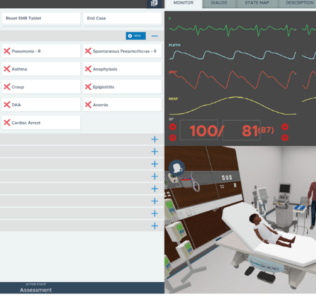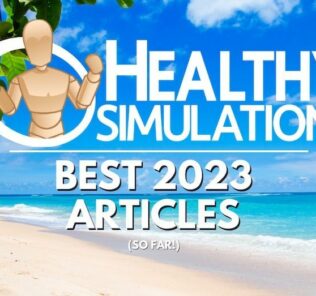Interviews With WISER Director, Dr. Paul Phrampus Part 1
While attending WISER’s 6th Annual Nursing Simulation Symposium I had a chance to sit down with Dr. Paul Phrampus, WISER Director and SSH President. I had such a great conversation with Paul that I will be sharing my video interview segment by segment here over the next couple of weeks. UPMC and WISER have a great historical connection with medical simulation and you can learn all about that, and the coverage of their recent Nursing Symposium, by watching and reading my previous event coverage. For today, watch the video below to learn more about Dr. Phrampus, how he got started in simulation, Pittsburgh’s modern transformation and UPMC.
INTERVIEW TRANSCRIPT:
Sponsored Content:
Meet Paul
Hi, Paul Phrampas here (pictured above right). I am the Director of the Winter Institute for Simulation Education and Research here also known as WISER. I’m an Associate Professor in the Departments of Emergency Medicine and Anesthesiology and Vice Chair for Patient Safety and Quality in the Department of Emergency Medicine. (Editors Note: Paul is also the current President of the Society for Simulation in Healthcare).
Lance: Tell us how you got to Pittsburgh?
Paul: So, I arrived in Pittsburgh in 1996 as a visiting medical student. I wanted to see what It would be like to be an emergency medicine resident here in Pittsburgh. In the month that I spent here I fell in love with the city and the training / university programs and the availability. I selected to come here for my residency and I was happy to actually match here and did my emergency medical training from 1997 to 2000 at the University of Pitt. And during residency I was lucky enough, actually serendipitously, to be put in touch with the simulation efforts and was able to start working in simulation in 1997, while I was completing my residency. One of my first projects was helping to create some competency courses for the city of Pittsburgh paramedics.
Sponsored Content:
Lance: This is my first time in Pittsburgh and I am in awe – not only by how many bridges are here – but how beautiful this city really is!
Paul: Pittsburgh as a city is surprising, I’ve lived in for the last 15 years and I have to say 15 years ago when I arrived here I was shocked. My childhood memories of Pittsburgh, and I think how a lot of people still imagine Pittsburgh, is as the steel mill town, a blue collar town, where the factories are churning out smoke day in day out and the street lights stay on 24 hours a day because of the smog. I was expecting to have my car parked on the sidewalk and get dust from the coal mines on it in two hours time, and I was delighted to see when I came out of the tunnel for the first time into the area, a hustling bustling clean city that’s vibrant. The steel mills are gone and the industries that are creating a thriving Pittsburgh today (after a long economic revitalization) are healthcare, education, and banking.
So its been a great seed for recruitment of healthcare providers, and people who are involved in technology in the city of Pittsburgh. There are also a great number of universities here. Of course, the two of which are world famous are the University of Pittsburgh and the Carnegie Melon University. Carnegie Melon is famous for computer engineering and robotics engineering in addition to a number of their other programs. The engineering aspects of these groups combined with the University of Pittsburgh engineering programs has been a delight for many collaborative projects in innovative projects for teaching education research and simulation itself. Pittsburgh is a great place to live and a great place to train. We have world class medical training facilities and training programs that engage people all throughout the entire region.
Lance: Tell me more about UPMC and some of the reasons it was just ranked #10 Nationally by US News?
Paul: UPMC, or the University of Pittsburgh Medical Center, has been formed over the last 20 years. It was a consolidation of a couple academic medical centers, and then the response to the changing market place. In terms of healthcare and the ability to thrive through consolidation, the opportunity was identified by our CEO many many years ago before people were even thinking about these concepts. Over the last 20 – 23 years UPMC has been able to create a fully integrated healthcare delivery network. We have our own insurance program with a couple of million lives insured and we currently have 19 hospitals and clinics, most of which are located throughout southwestern Pennsylvania. But, we also have healthcare facilities and hospitals in Ireland, in Palermo Italy, and are working in Asia with several different service lines of care delivery.
Here in Pittsburgh the UPMC has 13 different hospitals with common services where simulation comes into play. We have a chief quality officer that over sees a lot of the quality patient safety efforts in a lot of those hospitals, so from a system level we are able to raise the bar on quality. We are able to find unique and innovative ways to implement simulation or other innovative educational programs to ensure that we are providing the highest quality care at the most economical prices in the south western Pennsylvania area.
We are really quite big, and were recently ranked number 10 nationally by US News and World Report Honor Roll. A number of our programs are in the top three to five as far as training programs go, as we are a world class health institution with regard to transplant surgery. You may know that the first liver transplants were developed here and we are one of the busiest transplant centers in the country. People literally come from all over the world to not only get clinical care here but also to receive training at one of our many facilities.
To learn more about Paul and the WISER Center, visit http://www.wiser.pitt.edu!
Lance Baily, BA, EMT-B, is the Founder & CEO of HealthySimulation.com, which he started while serving as the Director of the Nevada System of Higher Education’s Clinical Simulation Center of Las Vegas back in 2010. Lance is also the Founder and acting Advisor to the Board of SimGHOSTS.org, the world’s only non-profit organization dedicated to supporting professionals operating healthcare simulation technologies. His co-edited Book: “Comprehensive Healthcare Simulation: Operations, Technology, and Innovative Practice” is cited as a key source for professional certification in the industry. Lance’s background also includes serving as a Simulation Technology Specialist for the LA Community College District, EMS fire fighting, Hollywood movie production, rescue diving, and global travel. He and his wife Abigail Baily, PhD live in Las Vegas, Nevada with their two amazing daughters.
Sponsored Content:



















